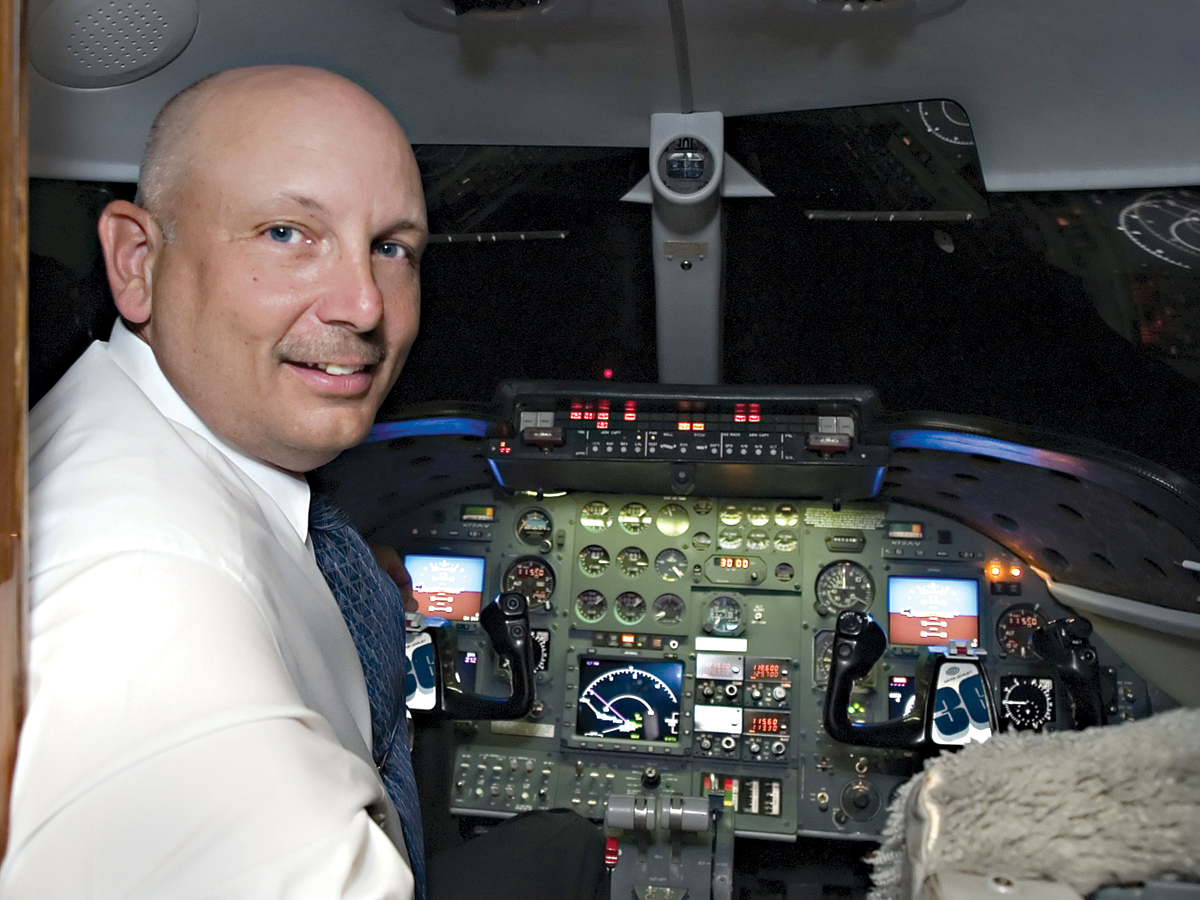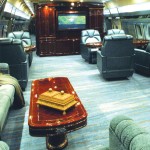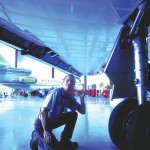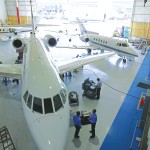By S. Clayton Moore,
A new era in aviation services is on its way. Landmark Aviation, a company born from one of the country’s largest aviation mergers in 2004, is raising the standards of business aviation services with an ambitious and innovative approach.
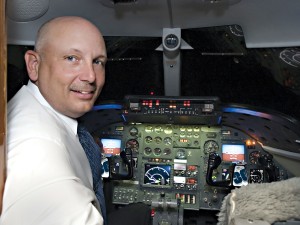
Leading Landmark’s ambitious strategy of integration and acquisition is CEO Roger Wolfe, seen here in a Lear 36 outfitted with EFIS flight displays and synthetic vision avionics.
With its recent acquisitions of fixed base operations in the critical markets of Scottsdale, Ariz., and Westchester County, N.Y., the company is on the verge of offering truly integrated coast-to-coast service for its wide range of corporate aviation clients. It now has 44 locations across the United States, offering everything from FBO services including fuel sales, to maintenance and repair operations, to sales and charter services.
“We have a very simple vision—to enhance the ownership and operating experience for every customer in aviation,” said Landmark CEO Roger Wolfe. “It’s very broad on purpose, so that we’re not defined by our boundaries. We have an incredibly wide range of offerings and we want to continue expanding those services for all of our customers.”
The company has evolved from an ambitious plan launched by The Carlyle Group, an international private equity firm based in Washington, D.C. In 1998, the firm purchased North Carolina-based Piedmont Hawthorne, one of the nation’s largest networks of FBOs offering service, charter and sales functions. That deal also secured the Dallas-based Associated Air Center, the world’s number one completion center for the Airbus A320 family of aircraft commonly known as the Airbus Corporate Jetliner.
At that point, Landmark began quietly planning a new image and strategy to take the company’s aviation services further than ever before.
In 2004, Landmark secured the crown jewel of its planned aviation network by acquiring Garrett Aviation from General Electric. Garrett, which had evolved over its 50-year history from an engine manufacturer into one of the country’s most robust aircraft modification and maintenance services, also brought expertise in airframe, avionics, paint and other modification programs.
A new landmark
Roger Wolfe is responsible for leading the company in defining its service offerings and brings a wealth of experience to the job. He joined the organization in early 2005 as executive vice president of operations, bringing a great deal of experience in aviation industry operations.
Most recently, he had been vice president and general manager of Honeywell’s $2 billion airframe systems business, general manager of Honeywell Aircraft Landing Systems, and had held progressively responsible positions at ITT Canon and AlliedSignal Aerospace Corp. Yet Wolfe admitted that bringing people together isn’t as easy as merging a company’s physical assets.
“We struggled with getting everyone to let go of their past identity,” he said. “We realized that if we adopted the Garrett name or the Piedmont name, we wouldn’t be able to start fresh. The first thing we did was to re-brand the company to say, ‘Here’s who we are today.'”
The first order of business in bringing together the range of diversity represented by Piedmont Hawthorne, Garrett Aviation and the Associated Air Center was getting rid of the company’s unruly moniker. Carlyle finally settled on the name Landmark Aviation to represent its full line of services.
“When it came down to the final field of names, we involved 100 of our best customers to choose from five names,” Wolfe recalled. “This one came out as their first choice. It really meant something to them: safety, security and the nautical and aeronautical connotation of a landmark to guide them home safely. That’s the message we want to deliver. When our corporate clientele comes to us, they can be assured of a job that’s done right and done safely.”
Beyond the company’s re-branding, it also had to find a way to join operations across more than 40 locations. That required a significant restructuring of its assets and resources.
One arm of Landmark did retain its name: the Associated Air Center. Established in 1948, it’s well known for performing modifications and completions on large aircraft. Keeping its identity separate was a conscious decision.
“Its clientele was so small and so specifically focused that we didn’t want to detract from their product offering,” Wolfe explained. “The other sites were larger but they have a lot of competition, too. We didn’t want to lose that Associated Air Center brand even though it still carries its Landmark association.”
The real trick was to bring the resources and competencies of all three companies together in a way that made sense both strategically and economically.
“We decided to differentiate ourselves from our individual competitors who are independent FBOs and MROs (maintenance and repair operations) by integrating all three businesses into one offering for the customer,” Wolfe explained. “Our strategy was to keep that customer from the moment he acquired an aircraft, by either selling it to him; chartering it for him; or servicing, repairing or upgrading that aircraft. In the end, we can sell it for him and the process starts all over again.”
The science and art of integration
To provide the most logical coverage of services, Landmark’s management consolidated their engine business into three locations and moved modifications, interiors and paint into a single location. Both moves provided advantages to the customer as well as the company.
“Here’s a good example,” Wolfe explained. “We now work 24/7 around-the-clock on engines, so when a customer delivers an engine to us, we literally never stop working on it until it’s time to ship again. That’s significantly reduced our cycle time on engines.”
By consolidating its paint, interior, modification and heavy airframe checks into a single location at Landmark’s facility in Springfield, N.C., the company was also able to establish a center of excellence and improve its capacity significantly.
“On any given day, we’ll have between 20 and 25 aircraft on the ground getting avionics and engine upgrades, interior and paint,” Wolfe observed. “It’s allowed us to develop an engineering expertise that is second to none, while also letting us concentrate our investment capital in one location.”
There were plenty of technical challenges, too. In addition to the simple movement of equipment and resources, Landmark paid for the development of an integrated Oracle-base billing, tracking and equipment database that brought all three businesses under one system. It’s invisible to customers but also offers them some unique advantages.
“First of all, they don’t get three different bills in the mail,” Wolfe explained. “They get one invoice. A customer also has to make far fewer calls in order to get service. For our part, we save on accounts payable and on our cash management, which allows us to be much more cost-competitive and aggressive in terms of our services offerings than we could in the past.”
The company invested months on training. Every Landmark employee, newly clothed in uniforms that carry Landmark’s vivid logo, was taught not only about the history of each of the three companies but also about their capabilities and resources.
“We spent a lot of time cross-training all the general managers and all of our employees at every site about the various aspects of our business,” Wolfe said. “We didn’t want to send the customer to another location. If he was dealing with an FBO and wanted MRO services, we wanted our staff to be able to tell him right then and there what services we offer.”
The effort has had the intended effect. Employees are now actively looking for opportunities where they can offer expanded services.
“Here’s why that’s so important,” Wolfe explained. “Typically, MRO guys used to compete for business. Now that we have an FBO chain with hangars, we have the opportunity to walk through to offer new interiors, avionics upgrades or engine inspections. Our employees can offer, right then and there, to help a customer stay in service. If they need to, they can offer them free fuel to ferry their aircraft to another location within the Landmark family to get the work done.”
Landmark’s managers are putting their money where their mouth is, when it comes to those opportunities. Wolfe and his team have put financial incentives in place to encourage employees across the country to seek out new ways to help customers.
“If an employee recognizes an opportunity, they just need to know whom to get in touch with to pass the opportunity along,” Wolfe said. “They get recognized not only for their initiative but also with monetary incentives. The money goes right to the site for awards, a barbecue, or an incentive to Disneyland. They now have a motivation to recognize and act on those opportunities because it benefits them directly.”
Wolfe had just returned from touring Landmark’s extensive network of FBO and MRO facilities along the eastern seaboard and was surprised by how well Landmark’s employees and customers had embraced the concept.
“What I learned was that our employees are way ahead of the curve and even ahead of our management in their zeal to find opportunities,” he said. “Why? Because customers are driving their efforts. When our customers saw the announcement that we were bringing our operations together, they recognized that we ought to be able to provide more services to them; they’re asking our employees to facilitate. That’s a huge incentive and it’s been a real pleasure to see that effort growing faster than we had anticipated.”
Growing the family
In fact, Landmark is very healthy these days. While the privately held Carlyle Group doesn’t release its numbers publicly, Wolfe confirmed that the aviation services firm is experiencing double-digit growth and is well on its well to a billion dollars in revenue annually.
Wolfe shares some of the credit for that success with his management team, who brings deep experience from major players in the aviation world such as Gulfstream Aerospace, Bombardier and Duncan Aviation.
“Our expertise is based on hiring top-notch, well-educated and experienced individuals who have the right connections,” he said. “That experience level allows us to make decisions much more quickly. We can take some shortcuts because we already know what will add value to our customers. Getting the best offering out there first so it never becomes a competitive bid is crucial. I couldn’t be happier with the management team we now have in place.”
Some of the team’s flexibility also comes from the enthusiastic backing of the Carlyle Group, one of the most well-funded private equity firms in the world.
“They believe in this integrated strategy,” Wolfe said of his backers. “They’ve seen the financial success that we’ve had but they’ve also personally experienced our services because many of them own their own business jets. It shows them what an integrated offering can deliver on a very personal level.”
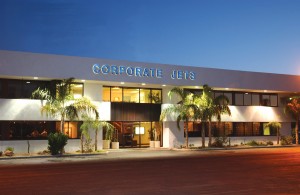
Landmark Aviation recently finalized its acquisition of Corporate Jets Inc., a full-service FBO with MRO and aircraft sales and charter at Scottsdale Airport.
Carlyle’s support has allowed Wolfe and his team to pursue an ambitious schedule of acquisitions that are designed to fill the gaps in Landmark’s coverage. The company recently made two significant tactical acquisitions. In January, Landmark took over operations at Skyport, a full-service FBO facility at the bustling Westchester County Airport (HPN) in New York, and in April it acquired Corporate Jets FBO in Scottsdale, Ariz (SDL).
“There are common factors in both these acquisitions,” Wolfe explained. “They’re both tier one cities with the right mix of aircraft to help us grow our integrated offerings. At the same time, we’re giving them a significant opportunity to improve their revenues.”
To further capitalize on their new FBOs, Landmark also dedicated a mobile service team to the Westchester and Scottsdale sites. These traveling, FAA-certified repair teams allow Landmark to extend its reach to outlying areas and even to new markets.
“We had this vision of launching these mobile service teams to service customers who were in trouble,” Wolfe recalled. “But they had an unintended benefit. They weren’t just being called in for emergencies. Corporate flight centers are calling them because we have a depth of expertise that they might not have to take care of an engine or an airframe problem in their own hangar. Their utilization is through the roof so we’re adding them as fast as we can.”
These new acquisitions are just part of an extensive plan to offer service from coast-to-coast.
“At any given time, I have a pre-approved list of about 20 potential acquisitions that have already passed our strategic filter and financial analysis,” Wolfe said. “Then it’s simply a matter of having our acquisition team approach a company to determine its willingness to become part of the Landmark family. We’re not afraid to make several small acquisitions or even a single large acquisition, if we feel it’s time.”
With 44 locations already in the Landmark family, Wolfe is even looking to expand beyond America.
“Here’s the additional twist,” he said. “The opportunities that we have for these integrated offerings span the globe. We already have our eyes on FBO acquisitions in the UK, Scotland, mainland Europe, and the Far and Middle East.”
With additional acquisitions already in mind, Wolfe is hoping that by building up Landmark’s density in certain areas, they can extend the impact of its brand.
“It’s about providing that branded service from Landmark,” he said. “We want to become better represented in the Midwest and on the West Coast, so we’re looking hot and heavy at acquisitions in those areas. We want our customers to be able to expect better service from Landmark than from any of our competitors. That’s the grand strategy behind these plans. We just want them to be able to get what they need from any of our locations.”
Singular service
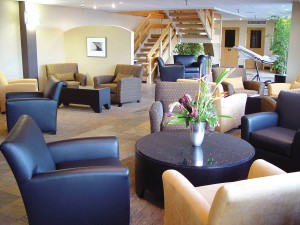
Full amenities are offered at the newest Landmark Aviation operation, including comfortable lounge and pilot areas.
Beyond the strategic planning, product development and financial tactics inherent in a job like Wolfe’s, he’s also deeply committed to his customers. By regularly reviewing the customer satisfaction index prepared for Landmark by Ducker Worldwide, a contract market intelligence firm, he keeps his fingers on the real pulse of the company.
“I look at all those numbers,” he said of the survey. “I don’t sacrifice that knowledge for time or strategy because that’s what sets us apart.”
Landmark’s commitment to customer satisfaction impacts every single employee. Each site is graded against their customer satisfaction index and that number is tied to a quarterly bonus.
“Our focus on customer service is over the top because it’s the primary differentiator in this business,” Wolfe said. “The majority of our CEOs and high-profile customers aren’t as price-driven as they are service-driven. Because we understand, we put teeth behind it; it’s what generates the bonus down to the last shop guy on the floor.”
Landmark is also launching a new program for customers called the Landmark Total Rewards MasterCard. The credit card will permit flight departments, pilots and other customers to earn redeemable points towards aircraft maintenance and service discounts, including savings on fuel and other purchases across the Landmark network.
“It’s just one more incentive for a customer to stay within our family,” Wolfe said. “It’s a regular credit card as well, so they can use it anywhere.”
The company continues to grow its business in all of its areas of expertise, including FBO and MRO operations, as well as completions. No arm of the business receives more attention or resources than another.
“From a customer’s standpoint, they use all of our services eventually, so each one is equally important,” Wolfe said. “When they come into an FBO, we know they’re eventually going to need engine maintenance or an airframe inspection or some sort of interior upgrade. That’s why we want to be the single solution, so that it’s easy for them to get the services they need.”
In the end, Wolfe is very pleased with the reaction from aviators around the country to Landmark’s integrated strategy.
“It’s been a fantastic strategy,” he said. “The employees are very happy and we’ve gotten a great response from our customers. If you want to talk aviation, you can talk to anyone in our company and they’ll know our customers, our products, our profile and the market. That’s huge.”
For more information about Landmark Aviation’s integrated service offerings, visit [http://www.landmarkaviation.com].
- Landmark’s Dallas facility, Associated Air Center, is responsible for maintenance, modifications and interior completions of large aircraft manufactured by Airbus, Boeing and Douglas.
- A Landmark Aviation technician performs an airframe inspection at one of the company’s 44 locations across the United States.
- Landmark technicians provide maintenance and repair operations for a wide diversity of business aircraft ranging from Bonanzas to the latest corporate jets.
- John Chalaris, executive vice president and CFO, is responsible for all the financial operations of Landmark’s billion-dollar business.
- Shawn Vick, president of Landmark Aviation, is developing Landmark’s market strategy, business development and execution.











